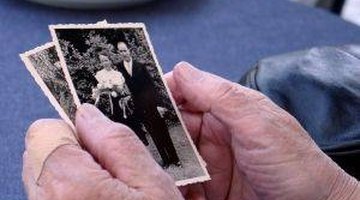How To Remove Mildew on Pictures
Stored photographs are susceptible to mildew, especially if they have been inadequately stored or have been exposed to flooding or high humidity levels. Preventive measures are ideal, but when mildew does grow and threaten to ruin cherished photos, there are safe ways to effectively deal with the problem.

Things You Will Need
- Rubber gloves
- Respiratory mask
- Protective eyewear
- Vacuum cleaner
- Mesh screen
- Plastic bag
Tip
Keep your home well ventilated at all times. Run a dehumidifier to control excess moisture in the air. If necessary, ask a local photographer for referrals to professionals who specialize in photo restoration. Do this for safety reasons or for those pictures that are invaluable to you.
Warning
Never allow mildew to come into contact with face or skin. Use HEPA filter masks to fully eliminate the chance of inhaling toxic mildew or mold spores. Educate yourself on mildew, mold and related health concerns.
-
Be cautious. The removal of mildew can be dangerous and cause respiratory problems, skin irritations or allergic reactions. Do not proceed on your own if you have respiratory issues, skin sensitivity, or moderate-to-severe allergies.
-
Wear proper gear, including rubber gloves, protective eyewear, a respiratory mask and clothing you can throw out or wash in hot water or bleach.
-
Separate photographs affected by mildew or mold. Isolate them from other pictures and objects so they do not spread the spores. Place them outside in a dry area that is well ventilated. Choose a day to do this when there is a low humidity level.
-
Let the mildew dry out. It will become dormant and turn into a powdery substance. Place the pictures in direct sun to aid in this process, but be aware that pictures can fade. Do not expose them to the sunlight for more than 30 minutes.
-
Remove the dried mold with a vacuum cleaner. Do this outside so the mildew does not infect your house. Place the photographs behind a wire mesh or old screen, and use the lowest setting possible in order to avoid damage.
-
Place the vacuum bag or contents from a canister in a plastic trash bag and immediately transfer it to an outside garbage can. Discard the screen and any affected boxes or storage units.
-
Place your pictures in a dry safe place for permanent storage. A cool dry closet in your home is an ideal location. Purchase photo storage boxes that are mildew resistant. Avoid storing in basements and attics, which are susceptible to mold and mildew.
Resources
Writer Bio
Melissa Lewis is a former elementary classroom teacher and media specialist. She has also written for various online publications. Lewis holds a Bachelor of Arts in psychology from the University of Maryland Baltimore County.
Photo Credits
- http://www.sxc.hu/photo/25560
- http://www.sxc.hu/photo/25560
More Articles



